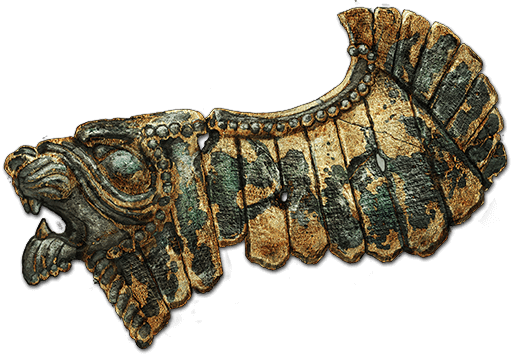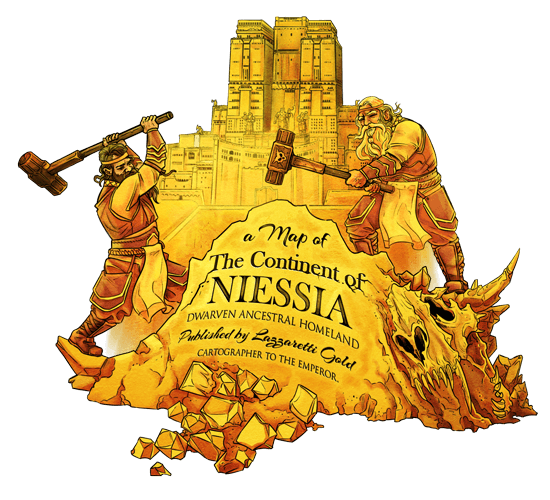N I E S S I A
Niessia is one of the prominent continents of Chaldea, adjoining the continent of Tamica to the north.
Niessia is separated from Tamica by the Garnon Forest and the wild Cloudforger Mountains. Both of these terrain features are nearly impassible without assistance from the locals, and both are kingdoms of Niessia.
Kingdoms of Niessia
Ardaya. A vast desert with lush canyons and fertile basins that the local people have learned to cultivate efficiently. Its capital is Raqmu and is inhabited by Ardayan humans. Ardayan camelry are some of the finest warriors of Chaldea and can frequently be found in auxilia units attached to Imperial legions. Ardaya’s principal exports are citrus, bows, spices, and oil.
Greymory. A kingdom in name only with no outward facing government, economy, or trade, Greymory, (also referred to as the Greymory Wastes) is an extremely hostile wasteland inhabited by grossly mutated flora and fauna. A volatile and rugged terrain properly avoided by all who value their lives. Intelligent species of humans, orcs, goblins, gnolls or even giants, (whether by choice or forced into exile), who have tarried too long on the toxic sludge of Lake Greymory or in the noxious fog that lingers above, rapidly and quite painfully transform into hideous misshapen outgrowths of terror. Like caterpillar’s transformation into butterflies, Greymory’s dark chrysalis properties tear down natural life and force a complete metamorphosis on its victims.
Griotunagardar. The plains, rivers, and hills that stretch from the Cloudforger Mountains eastward to the Great Sea. While considered a “giant kingdom,” Griotunagardar is under martial law, which is enforced by the humans of the 14th Legion. Peace is maintained primarily by keeping the humans to the farms and the capital of Svendborg and keeping the leirjotnar giants to the mudflats and networks of clay tunnels and lairs carved into the riverbanks.
Hesse. A well-developed human kingdom that spans the plains from the Cloudforger Mountains and badlands of Somacia westward to the sea. Its capital city of Augstat is the largest trading port of Niessia and is home to the headquarters of the Hecks, a united organization of knight orders, and the 10th Legion of the Imperial Army, and it’s where Governor Hellwig Gustavus, governor of Niessia, lives. Hesse’s principal exports are cloth, glass, metal works, pork, and rare herbs from the Garnon Forest, its northern neighbor.
Himyar. A landlocked area of dry plains and nomadic humans. Sometimes jokingly referred to as the land none of the neighbors wanted, Himyar is sandwiched between Hesse, Somacia, Kinahhu, Mycenae, Greymory, Niesse, and Stollhofen and has at one time or another been at war with all of them. The Himyarites are ethnically cousins to the Ardayans, and while they tend to prefer camels as mounts and transportation, they do also use horses. Their capital city is Zafar, and their exports are fruit, spices, and oil.
Jotunholm. This large expanse of impassible alpine mountains and year-around glaciers is home to the hrimthursar giants. They keep mostly to themselves, and they have no economy or trade to speak of. They are neighbors to Tavja in the south, Griotunagardar to the east, and the Tamica kingdoms of Andalus and Hakhamanesh to the west. Jotunholm has no capital city, but the giants are united through the widespread worship of Garrapa, the Six-Armed Goddess.
Kinahhu. A kingdom of coastal mountains, rich farmlands, and rugged arid highlands stretching from the badlands of Somacia eastward to the Great Sea. Its human peoples are the Kinaani and are known throughout Chaldea as great merchant traders and navigators of the Great Sea. From their capital city of Ugarit, the Kinaani export lumber (especially cedar), wine, oil, silver, wool, and mutton. As expansive traders, they import and re-export most anything, and they have trading offices in most Chaldean port cities. Their currency is the silver ugarit, with each city minting its own coins. They are bordered by Griotunagardar to the north, Somacia and Himyar to the west, and Mycenae to the south.
Munchkein. A kingdom of broad farming plains bordered by the Great Sea to the west, Hesse to the north, Himyar to the east, and Salominica and Stollhofen to the south. Munchkein is a close ally of Hesse, with whom they share strong cultural and ethnic ties. From their capital of Kofin, they engage in active coastal trading with Hesse and Tetonique but only during warm months, as their long, harsh winters often block coastal travel in the colder season. Their primary exports are grain and leather, and they use the Hessen currencies of silver groschen and pfinnigs.
Mycenae. A mountainous land that includes a vast archipelago in its shallow seacoast. A sunny, mild climate has helped the Myceneans develop a robust, diverse kingdom with numerous cities and trade, most of which is internal or with Kinahhu, in spite of the rampant piracy that pervades the islands. Their deep traditions of worship to the Olympic gods has made this a difficult kingdom for Kordaava and his church of Set to keep in line. Mycenae borders Kinahhu to the north, Himyar and Greymory to the west, and Ardaya to the south. Its capital city is Argos, its currency is the gold drachma, and its principal export is gold. Mycenaen heavy infantry, the Immortals, are some of the finest warriors of Chaldea and can frequently be found in auxilia units attached to Imperial legions.
Nabatean Trade Cities of Shivta, Avdat, Haluza, and Mamshit. The kingdom of Ardaya seeks to keep its culture pure by intermingling as little as possible with other kingdoms. In order to trade with other kingdoms, imports and exports are concentrated through four coastal cities that are ethnically an Ardayan minority called Nabateans, politically independent from Ardaya and from each other. Ardayans trade with the Nabateans, and the Nabateans, in turn, trade with the rest of the world.
Niesse. From the sky, Niesse’s Divinity Mountains look like an uninhabited stretch of vast alpine promontories, but at closer inspection, past their rugged beauty, five massive caliginous constructs ring the mountains: Brieg-goor, Brunn-goor, Gloggu-goor, Gorgbast-goor, and Molwitz-goor. These dwarven made fortresses are connected underground to the subterranean city of Tar-toor, the capital of a vast orc empire, wherein Sureniel rules from the Mithril Throne of Niesse. Sureniel, the elder diamond dragon who orchestrated the final destruction of the dwarves at the end of the Claw Hammer War has spent the intervening centuries forging a new species of hate-infused orc. Already prone to hate and violence, Sureniel further enhanced these proclivities, sharpening orc on a whetstone of evil doctrines and hysteria. Only their nascent fear of Emperor Kordaava and his drasildar keeps them warily at bay. There is no trade to speak of with Niesse, although some orcs will accept Ardayan bronze aretas—especially orc mercenaries—which is perhaps the closest thing there is to a Niesse export.
Salominica. Dominated by the preternatural Seaxe Forest, Salominica spreads westward from the Divinities to the Great Sea, bordering Munchkein and Stollhofen to the north, Tetonique to the south, and Niesse to the east. At one time, Salominica was established by the Andals, but the colony died out due to the harshness of the forest, which led to difficulties in food production, and the deposits of opals in Gem Stone Mountain that sparked initial interest failed quickly ran out. Today, the only signs of this once-promising colony are the ruins of its former capital, Leblon. One can still find human natives of Andal descent and scattered groups of elves, centaurs, and other fae.
Somacia. The badlands of Somacia have provided a natural defensive habitat for the warlike Somacians, who grew into a regional military powerhouse by using fast hit-and-run tactics against neighboring lands and then retreating into the badlands when faced with superior numbers. Bordering Tavja to the north, Hesse to the west, Kinahhu to the east, and Himyar to the south, Somacia has never had a shortage of targets for their horsemen, who complemented their forces with small, fast chariots as mobile archery platforms. The peace enforced by Emperor Kordaava has done wonders for their economy, bringing their exports of iron, copper, and silver into the limelight. Their primary currency is the silver mina, and their capital city is Hattusa.
Stollhofen. A small, landlocked kingdom sandwiched between Munchkein and Hesse to the north, Himyar to the east, and Salominica to the southwest. Stollhofen is a human kingdom with a large dwarven minority that descends from dwarven refugees who fled the Divinity Mountains when the orcs defeated the dwarves during the Claw Hammer War. These dwarves settled in the rugged hill country of Stollhofen and soon dug out the hills in the way dwarves know best. With the looming orc threat, the military of Stollhofen is one of the most prepared militaries of the peaceful Kordavan Empire, with combined strategizing by the local knight orders of the Hecks, the cohorts of the 10th Legion quartered here, and the dwarven host. They have no international trade to speak of, only a modest economy, and businesses in the capital of Hallstat are equally comfortable accepting Hessen groschen or the rings of bullion that dwarves keep threaded in their beards.
Tavja. The rugged alpine Cloudforger Mountains of Tavja dominate central Niessia. Tavja borders Jotunholm to the north, the Tamica kingdom of Andalus and the Garnon Forest to the west, Hesse to the southwest, Somacia to the south, and Griotunagardar to the east. Tavjans manage to farm and herd animals in the lower portions of the alpine mountains, but they are best known—and rightly feared—for their Norse raiders that fly in the skies on dire winged lions, pillaging the unwary and wary alike. A testament to their fierce prowess in battle, Tavja was the last kingdom to be conquered by Kordaava and his drasildar army, and only when facing the direct threat of Kordaava and his infamous Spear of Set, did Jarl Kulbrandr relent and bend a knee. The empire’s unrelenting influence, of course, has only had marginal success pressuring the Tavjan economy and lifestyle to conform to acceptable world standards. Tavja has tried to migrate to a peacetime economy based on trade in timber, barley, furs, and hides, but this has not been nearly as successful in the transition as have been their neighbors in Somacia. The capital of Tavja is the mountain stronghold of Danorum, which can only be reached by flight or extreme feats of mountaineering, (proof in the fact that Kordaava’s imperial legions never infiltrated Danorum’s defenses). Tavja, a male-dominated society, is widely despised for its oppressive treatment of women, who are generally treated as slaves, and is often compared unflatteringly to Akkadia, a female-dominated society.
The Garnon Forest. A primordial wide-reaching enchanted forest filled with mystical wonders and arcane secrets. It exists as a kingdom only in the minds of the Imperial autocrats, as there is no capital city or societal governing body, simply a wild, dangerous wood. Numerous supernatural and fairyland species call the forest home, most notably, fae, bugbears, lizardfolk, and elves. On the western edge of the Garnon, where the forest meets the Great Sea, resides the stygian bog, known as the Swamp of Khonn, the ancestral home of the enigmatic drasildar, commonly called “swamp demons,” the alliance with whom was crucial for the rise of Kordaava to power. The closest thing in the Garnon Forest to a settlement is the mystical town of Tartu, established at the base of a colossal, 4000-foot exposed root of Yggdrasil, “the Universe Tree”. The spiraling root loops arcing high over Tartu and the picturesque Tartulle Paradise valley where the veils to other extraplanar dimensions are weak, attracting mystics and planar travelers who seek fortunes and arcane lore beyond these curtains.
Governance. Emperor Kordaava considered many of these kingdoms too unstable for independent kingdom status and ruled them through a military governorship led by Governor Hellwig Gustavus. During the time since Gustavus was appointed governor, most of these kingdoms have come in line and are generally ruled independently, holding seats in the Imperial Senate.
Population. The ripe abundance of sentient species in Niessia easily surpasses all the other continents in Chaldea, with a very large population of orcs in Niesse, scattered settlements of elves and other fae in the Seaxe and Garnon Forests, a modest community of halflings in the Hessen capital of Augstat, and the largest population of dwarves in Chaldea in the rugged hills of Stollhofen. The Greymory Wastes is a quagmire of monstrous humanoids of goblins, gnolls, trolls, kobolds, ogres, and giants. Also, two kingdoms of Niessia—Jotunholm and Griotunagardar—are primarily home to giants. Even with all this flavorful diversity, however, well over half the population of Niessia is human.
Economy and Trade. Niessia hosts several great economies that hold their place on the world stage. These are the kingdoms of Hesse, Kinahhu, Mycenae, and the Nabatean Trade Cities. In addition, Munchkein and Somacia are significant regional players in Niessian trade.
Imperial Legions. Emperor Kordaava has three legions stationed in Niessia. The bulk of the 10th Legion, the War Hawks, is stationed in the castrum at Enchantments Guard, Hesse, and is commanded by Legatus Reiswitz von Gustavus. Also, three cohorts of the 10th are stationed in Stollhofen. The 14th Legion, The Harbingers, commanded by Legatus Vitorin, are stationed in their castrum in Stone Hold near Svendborg, Griotunagardar. And the 17th Legion, Eager for Battle, commanded by Legatus Frederick, is stationed in their castrum, the Anvil in Mycenae, near Argos. As with most of Kordaava’s legions, these are stationed near important capitals as a reminder of Imperial dominance.
Regional Militaries. Only Ardaya, Hesse, Mycenae, Niesse, Stollhofen, and Tavja have strong regional militaries. During Kordaava’s forty-year reign of peace, most kingdoms concluded “What’s the point?” and seriously reduced their military expenditures over the years.
Culture and Tourism. Only Augstat and Argos have significant tourism trade. Travelers to Augstat come primarily to see the architectural wonders of Altiflector and Enchantments Guard, while travelers to Argos enjoy its amphitheaters, where some of the greatest dramatists of Chaldea share their stories. Neither city has the level of tourism found in Bontroire, Esh, Gleam, Juba, Ombos, Regis, or the Imperial capital of Saratof. Throughout the rest of Chaldea, Niessia is considered a bit backwater, barely ahead of Sommaria.
C H A L D E A P E D I A











